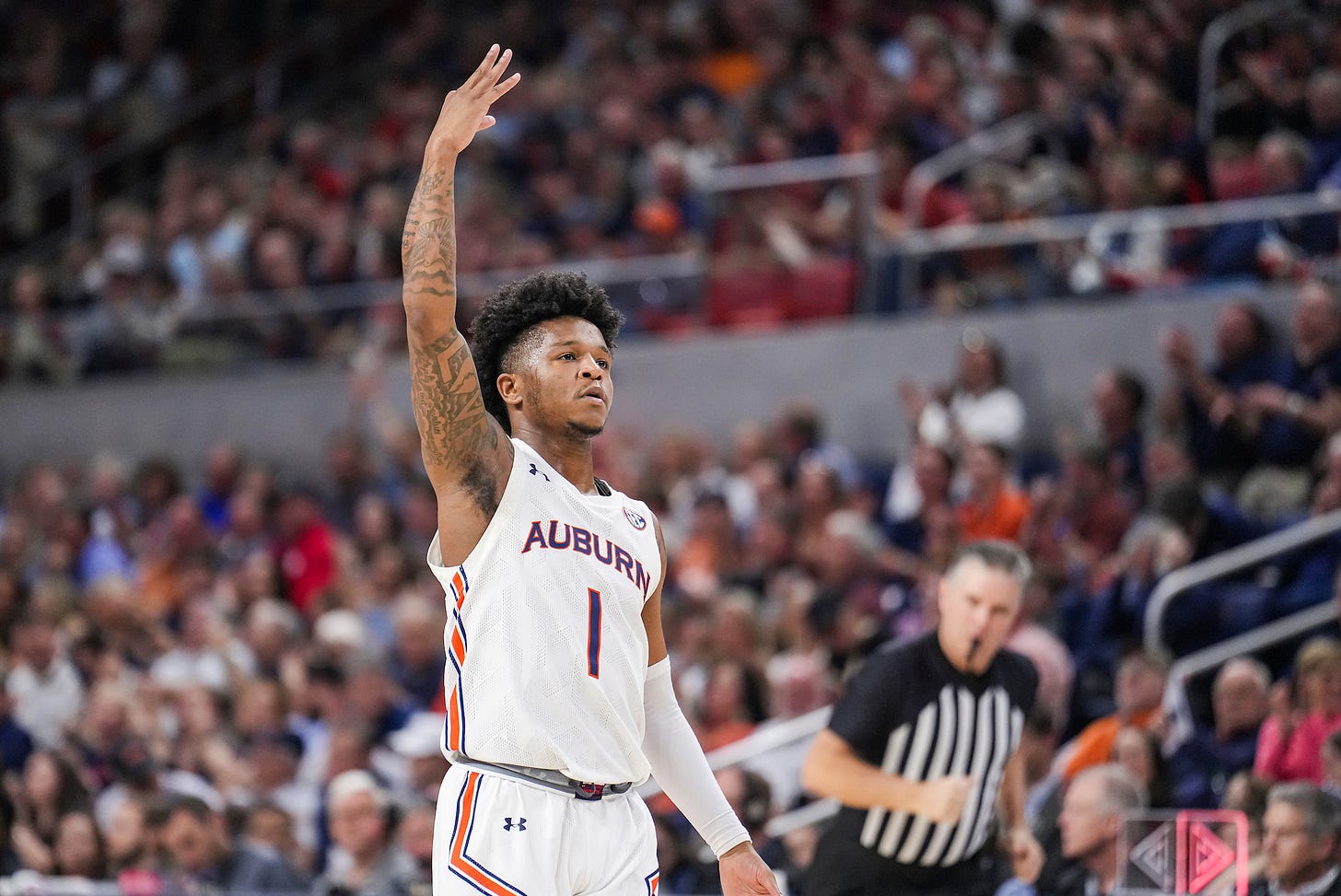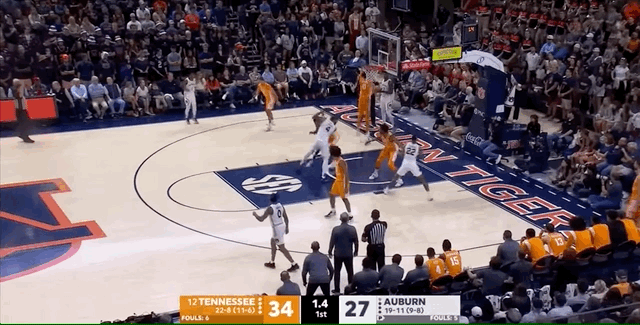How Auburn's 3-point shooting has gone from a weakness to a weapon
The Tigers have struggled from deep. But they've made a dramatic turnaround in that area — and it's coming at the perfect time.
PG Wendell Green Jr. (Steven Leonard/Auburn Athletics)
Auburn was on the wrong end of a 7-0 run to close the first half Saturday when Jaylin Williams went to inbound the ball under Tennessee’s basket with 1.4 seconds left on the clock.
Williams tried to get a pass down low to Johni Broome, and the Auburn center was fouled by Tennessee while the ball was still in the air. As Allen Flanigan checked back into the game and the referees went to the scorer’s table to ensure the clock was reset back to 1.4, Williams was flooded with suggestions from his teammates.
“At the end of the half, four guys told me they were gonna be open,” Williams said. “I was like, 'There's no way all four of y'all are gonna be open.' So K.D. (Johnson) said, 'I'mma go this way.' Johni said, 'Just throw it.' Al said, 'I'mma cut.'
“Then Wen's like…” Williams trailed off, mimicking Wendell Green Jr. flashing his hands open in the corner.
When Williams got the ball, everyone did as they said. Johnson rolled down to the opposite corner. Flanigan cut to the top of the key, aided by a Broome screen. And Green worked to shake his man in the near corner.
“I was like, 'Wen’s the closest,’” Williams said. “I had a 7-footer in front of me, so I just threw it to Wen. I mean, I trusted him to make that shot.”
Deep in the corner, the second-team All-SEC point guard caught the ball and pulled the trigger — beating the buzzer, shrinking Tennessee’s lead from seven to four at the half-time break and bringing some energy back into a nervous home crowd.
With the exception of Broome, every option for Williams was going to be a catch-and-shoot 3-pointer.
For most of the season, that would have been a less-than-ideal strategy for Auburn. After all, the Tigers are shooting just 31.4% from 3-point range this season, ranking inside the bottom 50 in Division I basketball.
And against that same elite Tennessee defense a month earlier, Auburn went an ice-cold 3-27 (11.1%) on 3-pointers in a 46-43 loss. The Volunteers, by the way, rank No. 1 nationally in adjusted defensive efficiency, and teams are only shooting 25.5% from deep on them this season.
But, since the Tigers offense hit rock bottom on Rocky Top, things have been a lot different.
According to T-Rank, Auburn is No. 24 nationally in adjusted offensive efficiency since Feb. 5 — the day after the road loss in Knoxville. That mark ranks No. 3 in the SEC during that time. Before then, Auburn was No. 72 in adjusted offensive efficiency.
And, if you look at all the stats, there aren’t many differences in how the Tigers have played on offense over the last month and how they were beforehand. Assist and turnover rates are nearly identical. Auburn isn’t getting to the free-throw line more often. There hasn’t been a noticeable spike in points off turnovers or fast-break buckets, either.
Instead, Auburn has made a massive jump into top-25 offense territory solely because of how much better it’s shooting from deep — and who it’s coming against.
Across its first 23 games of the season, Auburn shot just 28.8% on 3-pointers. Across its last four weeks, Auburn has jumped a full 10% to 38.8%, ranking No. 54 in Division I and No. 2 in the SEC, just slightly trailing Vanderbilt.
According to CBB Analytics, Auburn is shooting 31.6% on above-break 3-pointers and 31.7% on corner 3-pointers this season. But, over the last eight games, those percentages have jumped to 38.9% above the break (98th percentile nationally) and 43.8% (97th percentile nationally) in the corner.
The drastic changes in 3-point percentage can’t be explained away by a simple switch in attempt rate. The Tigers averaged 21 3-point attempts per game in their first 23 games of the season. Since the Tennessee game, they’re averaging… 20.6 3-point attempts per game.
And it’s also not like Auburn is just teeing off against bad defenses. Over the last eight games, it has played a top-three 3-point defense three different times and two more top-75 units. Only Missouri’s scramble-heavy defense, which Auburn scorched for nine 3-pointers on 18 attempts in a blowout win, is the truly weak one of the bunch.
Besides, Auburn shot a better percentage (60%) and hit more 3-pointers (12) on the road against Alabama’s No. 3 defense than it did against Missouri. Try explaining those numbers to somebody a couple of months ago.
The increased efficiency from beyond the arc has been a lift to everything Auburn does on offense. Over its last eight games, Auburn had five of its top six SEC performances in effective field goal percentage. It had four of its top seven offensive ratings and three of its top five turnover percentages, too.
It all culminated in Saturday’s win over Tennessee, when Auburn scored 79 points and had its most efficient day of offense against anybody not named Colgate, Winthrop or Georgia. After Green’s buzzer-beater to close the first half, Auburn hit its next four 3-pointers, all of them coming from a different player.
“To be able to get eight threes and shoot at the percentage, to be able to shoot 55% in the second half — it's good stuff,” Bruce Pearl said Saturday.
Auburn’s sudden jump from one of the nation’s worst shooting teams to one of its best begs the question: How is this happening?



